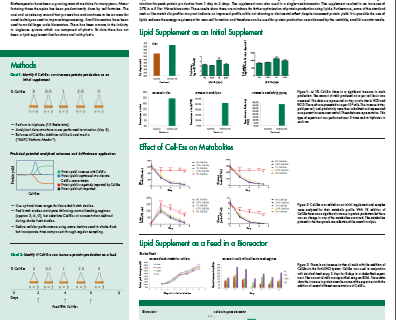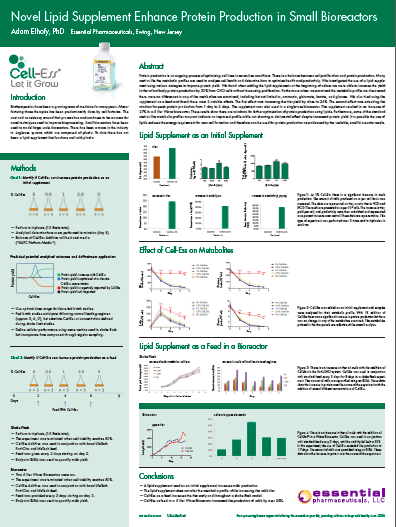
Novel Universal Titer Boost and Enhancer Improves CHO Cell Protein Production in Small Bioreactors
Background
Media optimization has been and continues to be a hot topic at any biomanufacturing conference. The Bioprocessing Summit in Boston last month was no exception. One poster, presented at the conference, which highlighted a novel opportunity for optimization was Essential Pharmaceuticals’ poster titled, “Novel lipid supplement enhances protein production in small bioreactors.” In the poster, Dr. Adam Elhofy, Ph.D. described a series of studies that examined the use of a lipid supplemented media enhancer to increase protein production at various stages and in different cell culture scenarios.
Historically, reagents that provided lipid supplements have had varying success on optimizing cell culture media and there have been issues reported in the literature around the use of certain lipids with certain plastics (1). With the increase in single-use systems, there is more plastic overall in the biomanufacturing process and so, the use of lipids as supplements would seem to be more challenging as a result. In one of the studies presented in the poster, Essential Pharmaceuticals used their universal titer boost and enhancer, Cell-Ess, to improve protein production in CHO cells using a 5 liter WAVE Bioreactor as the manufacturing vessel. The WAVE Bioreactor has been shown to prove scalability to larger vessels. Cell-Ess was able to achieve a greater than 25% increase in protein production using their supplement in this system. This would indicate that there is indeed an opportunity for a lipid enhanced media to work within a plastic environment.
Poster Highlights
Essential Pharmaceuticals’ Cell-Ess product is a serum-free, animal-free universal titer boost and enhancer. In their poster they describe a series of studies designed to investigate whether the use of Cell-Ess could improve protein production as an initial supplement and also as a feed when added to a previously optimized system. In addition, they wanted to look at the impact it could have in small bioreactors like the WAVE 5 liter.
First, they looked at the use of Cell-Ess as an initial supplement and the study was done in triplicate using CHO cells in shake flasks using SAFC Platform Media by Sigma-Aldrich. They found that when adding the Cell-Ess at the beginning of culture, they saw an increase in antibody protein production of 23%. (Figure 1) This increase was reached without increasing CHO cell proliferation. This is important because increasing titer through increased cell density can put a strain on downstream operations.
Figure 1:

Next, Cell-Ess was tested as a feed supplement by conducting feed experiments in both shake flasks and in the WAVE 5 liter bioreactor in CD FortiCHOTM Medium and Feed from ThermoFisher Scientific. Results of the shake flask study showed that Cell-Ess provided an increase in yield of 25% and extended the window for peak protein production from 1 day to 2 days (Figure 2).
Figure 2:

Figure 3: In the WAVE bioreactor, Cell-Ess provided an increase in yield of 27%

They also examined the metabolic profile to see if there was any impact on the metabolites, primarily ammonia, glutamate, lactate and glucose. They discovered that there was no change to the metabolic profile, which indicates that increasing the protein yield by adding lipids does not impact the standard metabolic profile (Figure 4).
Figure 4:

Summary
The poster demonstrates that there is an opportunity to optimize protein production using a lipid supplemented media enhancer, even in single-use systems, which historically have presented an issue for lipid supplements. In addition, there doesn’t appear to be any negative impact on either the metabolic profile or the cell density load for downstream operations. As stated in the poster, it may be that the use of lipids in culture reduces the energy requirement for new cell formation and therefore, this saved energy can be used for protein production instead.
Specific details about the study and results can be found in the poster below:
For more information, please see:
- An introductory 5-minute video on Cell-Ess can be viewed at https://www.youtube.com/watch?v=glFrm3jVePc.
For additional data in various cell lines and media systems, please visit
- http://www.cell-ess.com/cell-ess-bioprocessing-university/ to download presentations and case studies.
